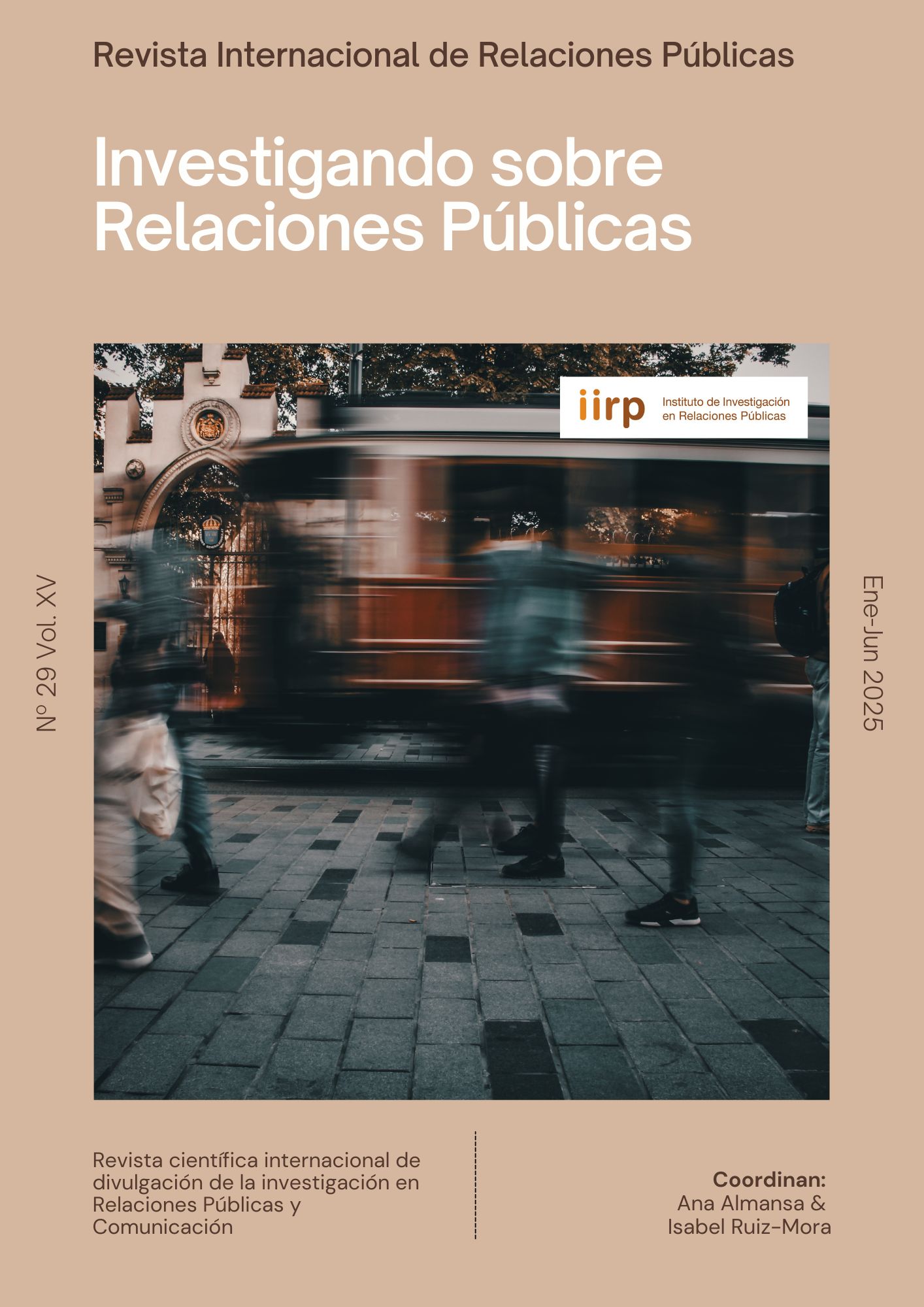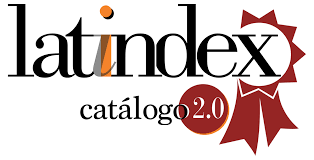State of internal communication in Spain: a scoping review (2014-2024)
DOI:
https://doi.org/10.5783/revrrpp.v15i29.891Keywords:
Internal communication, Corporate communication, Scoping reviews, Literature reviews, SpainAbstract
Internal communication has been gaining increasing relevance in academia, boosting research output in the field. However, to date, no indexed journal articles have been identified that focus on characterizing studies conducted in Spain in this area. In this context, this study conducts a scoping review of academic research on internal communication in Spain within the field of social sciences over the past decade.
The primary objective is to identify and characterize the most relevant academic articles in this area. In addition, several secondary objectives guide the research, including analyzing authorship patterns and institutional affiliations, identifying the most frequently addressed topics, and examining the bibliographic references cited in the studies. Furthermore, this study aims to classify the types of articles, determine their objects of study, and identify the predominant research methodologies used. Another key focus is identifying practical and theoretical implications, as well as research limitations reported by scholars in this field.
To ensure a systematic and rigorous research process, the SALSA framework (Search, Appraisal, Synthesis, Analysis) was applied. Moreover, the key elements of the PRISMA for Scoping Reviews (PRISMA-ScR) framework were followed to enhance transparency and replicability. The evidence base comprises twenty-five articles. These studies were retrieved from four major academic databases: Web of Science, Scopus, Dialnet, and Epsilon AI.
Moreover, the results show a high prevalence of co-authored articles and collaboration between universities. The analysis also indicates a clear trend toward studying internal communication in crisis contexts. Alongside crisis-related studies, there is also a strong presence of sector-specific analyses and case studies, particularly in industries such as healthcare and higher education. Beyond these dominant themes, the review identifies a growing interest in the relationship between internal communication, workplace well-being, and job satisfaction, as well as its connection to digitalization and its strategic role within organizations. Despite the wide range of topics explored, most studies exhibit a strong empirical orientation, although some literature reviews are also included in the sample. Qualitative methodologies predominate, surpassing both quantitative and mixed-method approaches. In terms of the object of study, research in this field focuses primarily on people, rather than on documents or digital communication platforms. Despite the notable increase in scholarly production on internal communication, several methodological limitations persist in the field. The most common issues include small sample sizes, self-selected or non-probabilistic sampling methods, and limited access to internal organizational data, which researchers often cite as a major obstacle. Finally, there is a paucity of practical implications and an absence of theoretical ones.
This study highlights the importance of continuing to study internal communication from a variety of perspectives. To advance the field, researchers should focus on broadening and strengthening methodological approaches, improving the representativeness of samples, and enhancing the applicability of research findings to real-world professional contexts. A more structured and systematic research agenda in this area would contribute to reinforcing theoretical frameworks, fostering academic cohesion, enhancing knowledge transfer, and increasing the practical impact of scholarly research. Addressing these challenges will allow internal communication research to evolve into a more influential and well-established academic discipline, making valuable contributions to both academia and professional practice
Downloads
References
Aced-Toledano, C., Arocas, M., y Miquel-Segarra, S. (2021). Manual de comunicación interna. Dircom, Asociación de Directivos de Comunicación.
Aced-Toledano, C., y Miquel-Segarra, S. (2021). La comunicación interna de las empresas españolas en clave estratégica. Revista Mediterránea de Comunicación, 12(2), 245-261. https://doi.org/10.14198/MEDCOM.18692
Anderson, S., Allen, P., Peckham, S., y Goodwin, N. (2008). Asking the right questions: Scoping studies in the commissioning of research on the organisation and delivery of health services. Health Research Policy and Systems, 6(1), 7. https://doi.org/10.1186/1478-4505-6-7
Andrade, H. (2002). Definición y alcance de la comunicación organizacional. En C. Fernández-Collado (Ed.), La comunicación en las organizaciones (pp. 11-17). Trillas.
Argenti, P. A. (2014). Comunicación estratégica y su contribución a la reputación. LID Editorial.
Arksey, H., y O’Malley, L. (2005). Scoping studies: Towards a methodological framework. International Journal of Social Research Methodology: Theory and Practice, 8(1), 19–32. https://doi.org/10.1080/1364557032000119616
Carreras, E., Alloza, Á., y Carreras, A. (2013). Reputación corporativa. LID Editorial.
Carretón-Ballester, C. (2007). Las relaciones públicas en la comunicación interna de la banca española. Netbiblio.
Carretón-Ballester, C., y Ramos-Soler, I. (2009). Las relaciones públicas en la gestión de la comunicación interna. Asociación de Investigadores en Relaciones Públicas.
Castillo-Esparcia, A. (2006). Las relaciones públicas internas como factor de gestión empresarial. Anàlisi, 34, 193-208. https://ddd.uab.cat/record/15576
Castro-Martínez, A., y Díaz-Morilla, P. (2021). La comunicación interna como área estratégica para la innovación a través de la gestión del cambio y la felicidad organizacional. Obra Digital: Revista de Comunicación, 20, 131-148. https://doi.org/10.25029/od.2021.293.20
Castro-Martínez, A., Díaz-Morilla, P., y Torres-Martín, J. L. (2022a). El papel de la comunicación interna en la gestión del teletrabajo durante la crisis de la COVID-19. Revista de Comunicación de la SEECI, 55, 29-51. https://doi.org/10.15198/seeci.2022.55.e768
Castro-Martínez, A., Díaz-Morilla, P., y Torres-Martín, J. L. (2022b). Comunicación interna, bienestar y felicidad organizacional en instituciones hospitalarias españolas durante la crisis de la COVID-19. Revista Internacional de Relaciones Públicas, 12(23), 143-162. https://doi.org/10.5783/revrrpp.v12i23.766
Castro-Martínez, A., Sosa Valcarcel, A., y Galarza Fernández, E. (2020). Comunicación interna, compromiso y bienestar de la plantilla: El caso de Admiral Seguros. Ámbitos: Revista Internacional de Comunicación, 48, 56-78.
Castro-Martínez, A., y Díaz-Morilla, P. (2020). Comunicación interna y gestión de bienestar y felicidad en la empresa española. El Profesional de la Información, 29(3). https://doi.org/10.3145/epi.2020.may.24
Corporate Excellence – Centre for Reputation Leadership, Dircom y DCH, Organización Internacional de Directivos de Capital Humano. (2018). Claves para entender la relación estratégica entre las áreas de Comunicación y Recursos Humanos. HR y Dircom International Forum. http://www.corporateexcellence.org/index.php/Compartimos-conocimiento/HR-Dircom-Claves-para-entender-la-relacion-estrategica-entre-las-areas-de-Comunicacion-y-Recursos-Humanos
Cuenca-Fontbona, J. (2018). Cómo hacer un plan estratégico de comunicación. Vol. III. La investigación estratégica preliminar. Editorial UOC.
Cuenca-Fontbona, J., y Verazzi, L. (2018). Guía fundamental de la comunicación interna. Editorial UOC.
Cuenca-Fontbona, J., Compte-Pujol, M., y Sueldo, M. (2022). The function of internal communication during the COVID-19 health crisis: Transformation or transubstantiation? Anàlisi: Quaderns de Comunicació i Cultura, 67, 7-26. https://doi.org/10.5565/rev/analisi.3553
Del Pozo Lite, M. (1997). Cultura empresarial y comunicación interna. Fragua Editorial.
Del Pozo Lite, M. (2015). Gestión de la comunicación interna en las organizaciones. Casos de empresa. EUNSA.
Elías, J., y Mascaray, J. (2003). Más allá de la comunicación interna. La intracomunicación. Gestión 2000.
Francés Tecles, E., y Camaño Puig, R. (2023). Comunicación interna en centros de atención primaria de salud: Una perspectiva de enfermería. Perspectivas de la Comunicación, 16(2).
García-Jiménez, J. (1998). La comunicación interna. Díaz de Santos.
Gonzalo-Molina, P. (1989). La comunicación interna en la empresa [Tesis doctoral, Universidad Complutense de Madrid].
Grant, M. J., y Booth, A. (2009). A typology of reviews: An analysis of 14 review types and associated methodologies. Health Information & Libraries Journal, 26(2), 91–108.
Greener, T. (1995). Imagen y relaciones públicas. Pirámide.
Hagen, L., Neely, S., Scharf, R., y Keller, T. E. (2020). Social media use for crisis and emergency risk communications during the Zika health crisis. Digital Government: Research and Practice, 1(2), 1-21. https://doi.org/10.1145/3372021
Kreps, G. (1995). La comunicación en las organizaciones. W. Iberoamericana.
Lebel, P. (1995). Organizar la comunicación interna. Gestión 2000.
Lucas-Martín, A. (1997). La comunicación en las empresas y en las organizaciones. Bosch.
Martínez-Romero, Y. A., y Yáber-Oltra, G. (2022). Tendencias de investigación sobre comunicación interna en revistas internacionales: 2015-2021. Revista Internacional de Relaciones Públicas, 12(23), 117-142. https://doi.org/10.5783/RIRP-23-2022-07-117-142
Matilla, K. (2008). Los modelos de planificación estratégica en la teoría de las relaciones públicas. UOC.
Miquel-Segarra, S., y Aced-Toledano, C. (2018). El rol de la comunicación interna ante los desafíos de la digitalización. Communication Papers: Media Literacy & Gender Studies, 7(15), 27-41. Universitat de Girona.
Miquel-Segarra, S., y Aced-Toledano, C. (2019a). El perfil de los responsables de comunicación interna en España. RAE-IC: Revista de la Asociación Española de Investigación de la Comunicación, 6(11), 99-118. https://doi.org/10.24137/raeic.6.11.7
Miquel-Segarra, S., y Aced-Toledano, C. (2019b). Objetivos y dificultades en la evaluación de la comunicación interna en las empresas españolas. El Profesional de la Información, 28(5), e280521. https://doi.org/10.3145/epi.2019.sep.21
Miquel-Segarra, S., Aced-Toledano, C., y López-de-Ayala, M. C. (2022). The impact of the Covid-19 pandemic. The perception of communications executives in companies: The role and challenges of internal communication. Anàlisi: Quaderns de Comunicació i Cultura, 67, 27-43. https://doi.org/10.5565/rev/analisi.3559
Munn, Z., Peters, M. D. J., Stern, C., Tufanaru, C., McArthur, A., y Aromataris, E. (2018). Systematic review or scoping review? Guidance for authors when choosing between a systematic or scoping review approach. BMC Medical Research Methodology, 18(1). https://doi.org/10.1186/s12874-018-0611-x
Ongallo, C. (2001). La comunicación interna en la empresa española. Ediciones La Coria.
Ongallo, C. (2007). Manual de comunicación: guía para gestionar el conocimiento, la información y las relaciones humanas en empresas y organizaciones (2.ª ed.). Editorial Dykinson.
Paradinas-Márquez, M. C., y Vicente-Pascual, J. A. (2024). Elementos clave de la comunicación interna para la gestión de las relaciones laborales y el conflicto: Aplicación al sector hotelero. European Public & Social Innovation Review, 9, 01-17. https://doi.org/10.31637/epsir-2024-609
Pineda-Martínez, P., y Ruiz-Mora, I. (2019). Comunicación interna y narrativas transmedia, nuevas estrategias para la empresa responsable: Estudio de caso de Telefónica. Revista Mediterránea de Comunicación, 12(2), 245-261. https://doi.org/10.14198/MEDCOM2019.10.2.11
Segarra-Saavedra, J., Cascales-Gonzálvez, B., y Carretón-Ballester, C. (2021). Análisis bibliométrico de las tesis doctorales españolas sobre “comunicación interna” (1986/2019). Revista Internacional de Relaciones Públicas, 11(21), 69-96.
Tricco, A. C., Lillie, E., Zarin, W., O'Brien, K. K., Colquhoun, H., Levac, D., Moher, D., Peters, M. D., Horsley, T., Weeks, L., Hempel, S., Akl, E. A., Chang, C., McGowan, J., Stewart, L., Hartling, L., Aldcroft, A., Wilson, M. G., Garritty, C., Lewin, S., Godfrey, C. M., Macdonald, M. T., Langlois, E. V., Soares-Weiser, K., Moriarty, J., Clifford, T., Tunçalp, Ö., y Straus, S. E. (2018). PRISMA Extension for Scoping Reviews (PRISMA-ScR): Checklist and Explanation. Annals of Internal Medicine, 169(7), 467-473.
Wang, Y., Hao, H., y Platt, L. S. (2021). Examining risk and crisis communications of government agencies and stakeholders during early stages of COVID-19 on Twitter. Computers in Human Behavior, 114, 106568. https://doi.org/10.1016/j.chb.2020.106568
Zerfass, A., Tench, R., Verhoeven, P., Verčič, D., y Moreno, A. (2018). European Communication Monitor 2018. EACD/EUPRERA, Quadriga Media.
Downloads
Published
How to Cite
Issue
Section
License
Copyright (c) 2025 Anna Ll. Francés-Renau, Susana Miquel-Segarra

This work is licensed under a Creative Commons Attribution-NonCommercial-NoDerivatives 4.0 International License.
Authors publishing in this journal agree to the following terms:
a. Authors retain copyright and grant the journal the right to be the first publication of the work as licensed under a Creative Commons Attribution License that allows others to share the work with an acknowledgement of authorship of the work and initial publication in this journal.
b. Authors may separately enter into additional arrangements for non-exclusive distribution of the version of the work published in the journal (e.g., placing it in an institutional repository or publishing it in a book), with an acknowledgement of initial publication in this journal.
c. Authors are allowed and encouraged to disseminate their work electronically (e.g. in institutional repositories or on their own website) before and during the submission process, as it can lead to productive exchanges, as well as earlier and higher citation of published work (see The Effect of Open Access).





